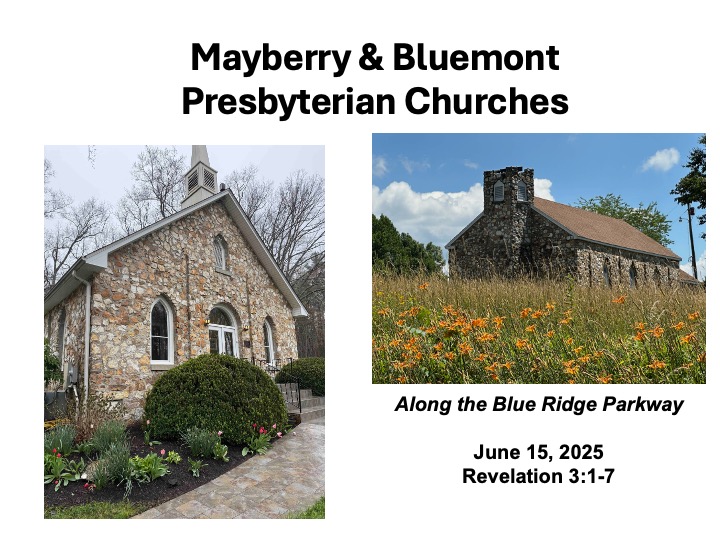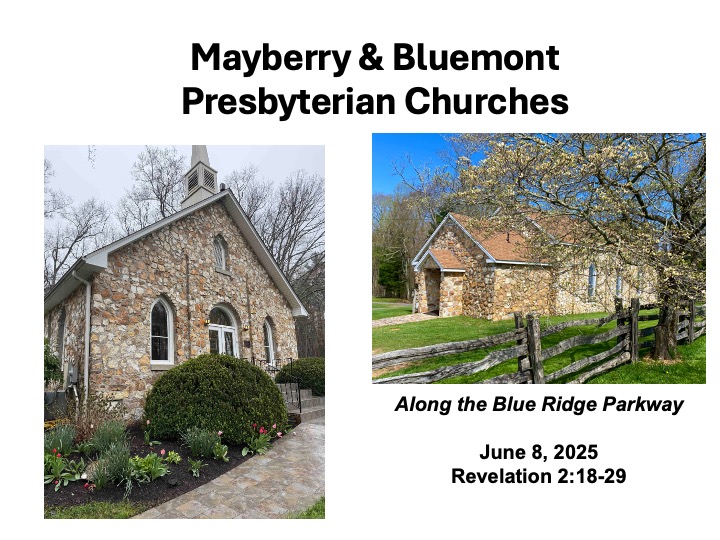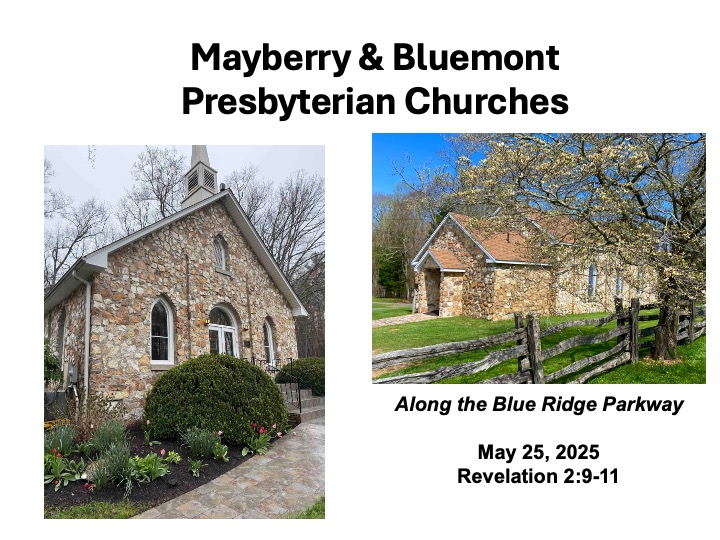Jeff Garrison
Mayberry and Bluemont Churches
June 15, 2025
Revelation 3:1-7
At the beginning of worship:
One of the most embarrassing things I’ve done as an employee occurred the summer after I graduated from high school. I’d been working at Wilson’s Supermarket since I was 16. Back then, the store closed at nine. After the floors were mopped, the stockers came in and filled the shelves. That summer, for the promise of more money, I agreed to work night shift when someone was on vacation. It was hard work. Even harder because I spent the days on the beach or running around with friends. Young and invincible, who needs sleep?
I reported to work at 11 PM. One night, I got home around 9 PM. My family had gone on vacation without me. Alone, I had run without sleep for days. I decided to take a nap before going in—so I set the alarm for 10:45 and fell asleep, dressed for work. I woke up and it was nearly 3 AM, the alarm had gone off and died. I’d slept right through it. I felt like a fool going to work four hours late. It was probably only because I had been a reliable employee in the past that I wasn’t fired. But it was the last week I worked night shift at the supermarket which was okay with me. I could have used a “wake-up call.”
All of us, at one time or another, can benefit from a wake-up call. And most of us have received them. Maybe it’s a note from the Dean of your college saying, shape up or ship out. I got one of them, too. Maybe it’s your doctor telling you to get your cholesterol under control or to ditch the cigarettes if you want to live to see your children grow up. Maybe it’s a reminder from your spouse which forces you to deal with what’s important. Wake-up calls can be a good thing. They force us to concentrate on what’s important and hopefully allow us to make the changes needed in our lives.
Before reading the scripture:
Today will be our fifth city as we work our way through the seven churches of Revelation. We’ll stop at Sardis. Get out your right hand up as a map. Tuck your thumb in and hold your hand sideways. If you remember, we started our journey at Ephesus, a city on the coast that’s located at the tip of your ring finger. Then we moved up over a peninsula of land to the city of Smyrna, also on the coast, some forty miles north, on your hand about the tip of your big finger Then we traveled further up the coast, then inland a bit to the beautiful city of Pergamum. Last week, we moved inland a bit more, to about where your knuckle of your big figure is at to the city of Thyatira.
Today, we’re moving about forty miles southeast to Sardis. As I’ve mentioned, the seven cities make a circle, and you can now see the circle taking shape.
This is a sobering letter. While there’s no mention of heresy nor reference to persecution, the Christians of Sardis receive the harshest message of all the seven letters. They think they’re alive and doing well, but they are dying. Of the seven churches, I wonder if the church in America isn’t most closely related to Sardis. This is a haunting letter. The church in Sardis appears to be growing and flourishing, but underneath it’s rotten at the core. The church lost its focus. It no longer values of the gospel. It no longer bears the fruits of the spirit: love, joy, patience, kindness, goodness, faithfulness.[1]
There is a personal side to these messages. If we know something about the city, we have clues into Jesus’ message. Sardis was a proud city with an enviable past. In the 6th Century BC, it was one of the most powerful cities in Asia, but by the time of the Romans, it was considered a relic of the past.
Situated on a 1500-foot-high acropolis, high above the surrounding valley, Sardis could easily be defended. But twice in its history, the city guards slept while enemy soldiers slipped into the city and attacked from the inside.[2] With that in mind, let’s listen to what Jesus has to say to Sardis.
Read Revelation 3:1-8
In Mitch Albom’s novella, for one more day, a man receives a wake-up call. Chick, a former professional baseball player and top-notch salesman, spiraled into a drunken failure. When he wasn’t invited to his daughter’s wedding because of his drinking, he attempts suicide. But he miraculously lives and while lying on the stretcher, his mother comes to him one last time. You’re not sure if it’s real or a vision. Afterwards, he gives up drinking and tries his best to help others. He works for the local Parks and Recreation Department. Shortly before his death, he asks that he be remembered for his final years, not the glorious years as a ballplayer. Those years, he was like Sardis, alive but nearly dead. The booze only numbed the pain.
Not being invited to the wedding and his mother’s visit in the hospital served as wake-up calls. He turns his life around, reconciling his differences with his daughter.[3]
Sardis receives a wake-up call. The church there, much like the city, and much like Chick in Albom’s story, lives on past reputation. As I’d said earlier, the city had once been a jewel of Asia, but by the first century had become a shell of its past. Its citizens still basked in their former reputation, but times have changed.
There wasn’t much to be bragging about within the church in Sardis. Too many of the Christians forgot what they’d been taught by their mothers and fathers and other who influenced their faith. Spiritually, they’re dead.
Jesus tells them that he’s coming like a thief in the night, a warning that should have caught the attention of the residents of Sardis. After all, the city’s location made it a natural fort. Yet, the city twice fell when enemy forces slipped inside the city—as thieves in the night. When Jesus tells them to stay awake, they recall those who supposedly watched their gates but napped on the job.
While the thief in the night illustration might be seen as a warning for the end times, we must also remember all but one of the cities have disappeared.[4] Our time is up when we leave this place. We only have the present to get right with God.
Unlike other cities, the problem with Sardis isn’t heresy or great sins committed by the church. Unlike last week, we don’t have any Jezebels encouraging wild parties in pagan temples. Instead of transgressions, the church in Sardis adopted the culture of its community. There isn’t anything which distinguishes itself from those not in the church.
Unfortunately, this is often true for the church in America. Numerous surveys show that Christians are just as likely to divorce as non-Christians. Child and spouse abuse seems to know no religious boundaries. Professing Christians have headed companies which frauded shareholders and employees and the public. I’ve known several “committed Christians” who embezzled from their employers.
Does our faith make any difference in our lives? Does being a follower of Jesus change who we are and how we act and how we relate to one another? If we say Jesus is our Lord and Savior, does it make any difference in the decisions we make here at church, in our homes, in our communities, at our workplaces? Do we make our decisions based on our faith in Jesus, or on what we think will get us ahead the fastest?
Sardis received a warning. “Wake up,” Jesus says, “some of you still haven’t spoiled your clothes.” In other words, some of the Christians in Sardis haven’t sold out what they believe in. But most have. The same is true for the church today. There are still Christians who, because of their Christian faith, stand up for what they believe even though it is uncomfortable and goes against the norms of society. Sometimes it cost them their jobs. They lose friends and their status in the community. But they retain their honor, their dignity.
Jesus tells the church in Sardis that those who conquer, in other words those who are awake and who strive to live the gospel, will receive a three-fold promise. First, they too will be clothed in white robes, which is the dress of the saints in the book of Revelations. Even if their clothes are now stained, there is still a chance for them to wake up, to repent, to turn around, and put on new clothes.
Second, their names will remain in the book of life—but the implied threat here is that those who are do not repent will not find their names in the book of life. The blotting out of names from the book of life probably refers to an ancient practice of removing the names of criminals from a city’s roll, thereby denying citizenship protection.[5] Even though we are saved by the grace of our Savior, we have a responsibility for our actions. We are to be stewards of all God gives us, using our gifts in a way that will bring him glory and honor.
Finally, for those who conqueror, Jesus will put a good word in for them with the Father. Jesus, as Paul reminds us, “prays for us.”[6]
The decision is in the hands of the folks in Sardis—will they wake up or will they continue sleeping and face the coming judgment? We, too, must make such a decision. Amen.
[1] Galatians 5:22
[2] Robert H. Mounce, The Book of Revelation, revised, NICNT (Grand Rapids: Eerdmans, 91-2.
[3] Mitch Albom, for one more day (New York: Hyperion, 2006).
[4] As we’ve seen, only Smyrna still exists as a city. https://fromarockyhillside.com/2025/05/25/smyrna-poor-yet-rich/
[5] Mounce, 96-7.
[6] Romans 8:34 (the NRSV says intercedes instead of prays)









